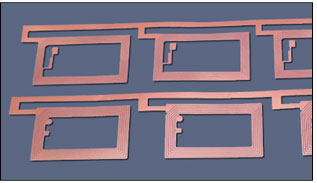Worried about the cost of RFID tags? It may be cheaper to grow your own—at least the tag antenna. QinetiQ (pronounced ki-NE-tik, as in “kinetic energy”), a science and technology company based in Farnborough, England, has inked a deal with Sun Chemical of the United States under which Sun’s Coates Screen business unit in the United Kingdom will produce special inks, based on QinetiQ formulations, that can be used to “grow” metal for antennas and other uses.
“We’ve taken a base ink supplied by Coates and added to it technology that allows you to print with this ink and then grow metal wherever there is ink,” says Christopher Bishop, director and GM of QinetiQ Metal Printing. “Our process is at least 50 percent cheaper than manufacturing metal antennas the conventional way.”
RFID antennas are typically made by taking a sheet of copper and etching away layers until you get to the desired thickness. This is an expensive, time-consuming process that creates chemical waste. With the QinetiQ method, the specially formulated ink is printed on a substrate—cardboard, polyester, polystyrene and other materials used for RFID tags—and the substrate is then passed through an electroless solution. Instead of using electric current to deposit metal onto a surface, which is what happens with electroplating, an electroless solution uses chemicals. In QinetiQ’s case, the metal in the solution reacts with chemical in the ink and is deposited on the substrate wherever there is ink.
The method can be used to deposit a layer of not just copper, but also nickel, gold, cobalt and other metals. It takes 2 to 3 minutes in the electroless solution to grow metal about 0.2 to 0.3 microns thick. A typical UHF antenna is about 2 microns thick, and a 13.56 MHz antenna is usually about15 to 20 microns thick. To make the antenna thicker, Qinetic takes the antennas out of the electroless solution and uses electroplating to add 5 microns of metal to the antenna per minute.
QinetiQ will also work with customers to develop antennas of the appropriate thickness based on the application. For instance, if achieving the longest read range possible is important, the process can be set up to produce antennas of greater thickness. The base inks can also be formulated for use on different types of substrates used for the RFID tag. This ensures that the ink adheres well to the substrate and the antenna doesn’t crack if the substrate is bent.
Bishop says that the system cuts the total cost of producing antennas—including materials, capital equipment and floor space used—in half compared with the conventional method of etching copper antennas. The antennas can be produced on a roll-to-roll machine to increase the speed of antenna production.
The ink can even be printed over the metal straps attached to an RFID chip embedded in a substrate. When the straps are immersed in the electroless solution, metal not only grows up from the ink, but also grows down through the gaps in the molecules in the ink to form a bond with the metal straps, creating an electrical connection between the chip and the antenna. That eliminates the process of attaching the antenna to the chip because the metal grows onto the connection pads.
Bishop also claims that RFID tags with antennas made from this process perform as well as tags manufactured conventionally because the “grown” antenna is “fully densified” metal, which means it has the same physical and electrical properties of ordinary metal. He adds that the process is even less expensive than antennas printed with metallic inks or conductive polymers, which often don’t deliver the same read range as solid metal antennas do because they don’t conduct electricity as well.
RFID tag producers that want to use this process—Bishop says several already are under nondisclosure agreements—can buy ink from QinetiQ and license the process for growing the metal. QinetiQ will then place an order with Coates, which manufacturers the ink and delivers it to the customer. Customers can use off-the-shelf electroless solutions from a wide variety of companies.
“We believe this technology will be widely and rapidly adopted across both new and emerging sectors, such as RFID,” says Andy Parkinson, global marketing manager for Coates Screen. “You can apply the ink with ink-jet, rotary and flat-screen, spray, gravure, flexo and offset printers.”
Attend RFID Journal University
There are just few days left
until
RFID Journal University
in
the Washington, D.C., area. This unbiased educational course, presented
by
RFID Journal and members of Auto-ID Labs, is designed to provide
the
fundamental understanding of RFID needed to begin a successful pilot.
Register
today, or
to learn more, visit RFID
U.


